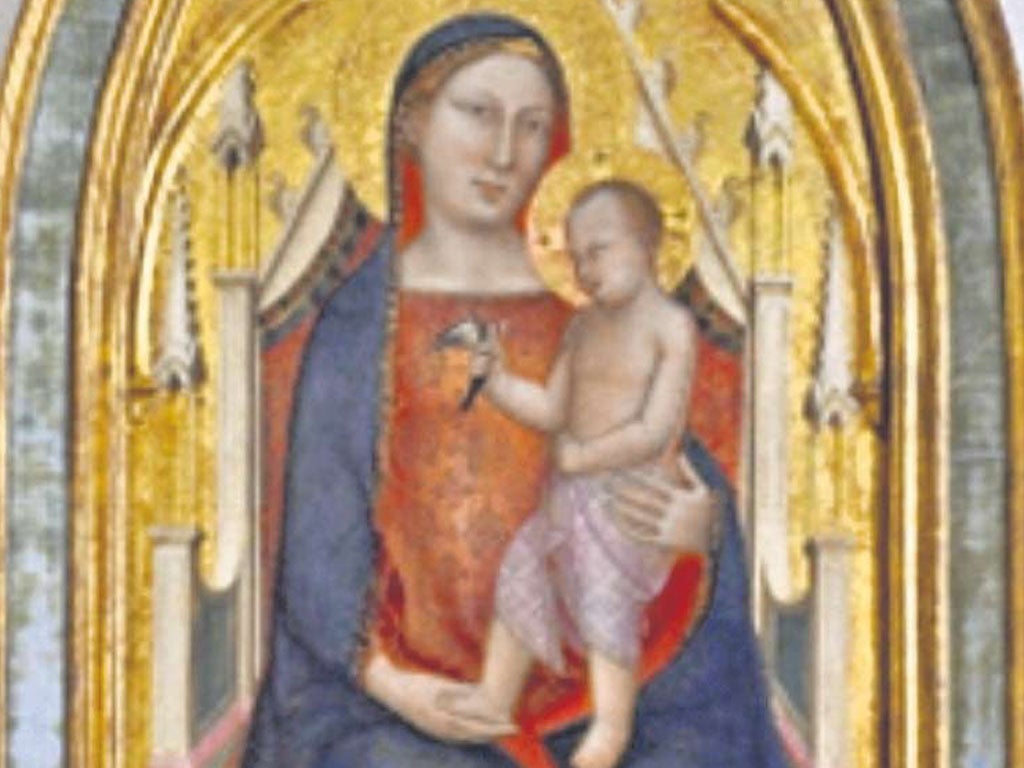When George Bush invaded Iraq, life imitated art
Born-again Christians often don't realise their 'God-given' right to invade Iraq destroyed one of the oldest Christian communities in the Middle East


In the late 1340s, Bernardo Daddi of Florence painted The Virgin and Child with a Donor.
The anonymous donor stands, tiny and in prayer, at the very bottom of the frame, while a monumental virgin – black-cowled, a bright red embroided dress over a very flat chest – holds a slightly sinister-eyed Christ who is, in turn, holding an open-beaked goldfinch. The finch, like many Renaissance birds, has its own symbolism; it eats thorns and is thus a precursor of the thorn crown which Christ will wear three decades later.
But what struck me was the pink cloth that the baby Christ is wearing. For on its fringe is what appears to be Arabic script. Close inspection – or as close as I could get at the Art Gallery of Ontario, where “Revealing the Early Renaissance: Stories and Secrets in Florentine Art” is showing – suggest that the letters only appear to be Arabic. There might be a “-lah” or even a “k” (kaf), but it makes no sense. In his exhibition notes, Victor Schmidt calls it a “pseudo-Arabic inscription”.
A bit odd, this. The Florentines were familiar with the Islamic world. Dante Alighieri placed the Prophet Mohamed in the eighth circle of hell in his Divine Comedies; and while the Crusades had effectively ended a century and a half earlier, the Florentines kept up a brisk trade with the silk manufacturers of Syria. Muslim-Christian society was still flourishing in Andalusia. Yet Bernardo Daddi couldn’t be bothered to use a line of real Arabic.
Florence was at this time the most powerful economic centre in Europe and its bankers and merchants could afford to assuage their fear of hellfire by employing the great painters of their time to honour God. But while they knew that Jesus died above a city called Jerusalem, their illustrations of the Holy Land were peculiarly European.
True, there is blood aplenty in these works. It spurts from the neck of John the Baptist, spools on to a skull from Christ’s spear wound, pours from the severed breasts of poor Saint Agatha. But while the Middle East was then – as now – a place of suffering, so was early Renaissance Europe. Burning at the stake, pressing to death, beheading, were all part of Middle Ages Europe.
And the helmeted “Roman” soldiers who accompany Christ to his crucifixion in Pacino di Bonaguida’s Scenes From The Life Of Christ are clearly wearing the clothes of an Italian Renaissance army.
Donkeys and cows slumber at cribs, dogs sleep beside their masters, but there are no camels and, suspiciously, no deserts. There is an elephant observing Jesus in Pacino’s The Creation of the World, along with some lively deer, while the skies, far from exuding heat, are usually a deep cerulean blue. The gold reflects Christ’s glory – not the sun – and the trees in these works, mostly neat Italian pines, are obviously European, with only some rather weird cactus-type plants appearing at the borders. Buildings, such as they exist, are Italianate churches and city walls.
In other words, this is a Europeanised Christ, just as Brueghel and the Dutch Old Masters would later place Jesus amid the frosts and low-roofed barns of the Low Countries. The rocks in Florentine painting might be in the Judean desert – in Pacino’s The Resurrection, for example – but they could also be in the Apennines. Was it the Renaissance that localised Jesus into a European geography?
After all, the earlier Crusaders knew real cartography all too well. Their castles, including the now civil war-wounded Krak des Chevaliers in present-day Syria, had “Europeanised” the architecture of the Middle East. These castles, I have decided after much prowling over their battlements – a singularly unacademic view, I know – were Gothic cathedrals with fortress walls instead of flying buttresses.
By the Renaissance, however, there was a place called “Christendom” which was definitely not in the Middle East. That’s what most of western and central Europe was then called – it started somewhere north-west of what is now Bosnia, along the Ottoman frontier.
Christ, in other words, belonged to “us”. And did those feet in ancient time walk upon England’s mountains green? No, of course not. But we had, by the 18th and 19th centuries, so appropriated Christianity that Jesus might as well have been born in England. Or America.
And so, of course, we arrive at the Bible Belt and such born-again Christians as George W. Bush who still, apparently, does not realise that his God-given right to invade Iraq led directly to the destruction of one of the oldest Christian communities in the Middle East.
Thus, Bush was able to call for a crusade in the Muslim world and to talk about Good and Evil without realising that for him, as for the painters of Florence, Jesus came from the West rather than the Middle East. That’s why Bush advanced the cause, not of the US Constitution but of the Bible. But where did all this start? Dare we blame Giotto?
Join our commenting forum
Join thought-provoking conversations, follow other Independent readers and see their replies
Comments
Bookmark popover
Removed from bookmarks